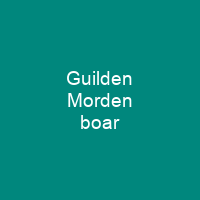The Guilden Morden Boar: A Timeless Symbol of Anglo-Saxon Ingenuity
Imagine, if you will, a time when the land was ruled by fierce warriors and their mighty boar-crested helmets. The Guilden Morden boar, a sixth or seventh-century Anglo-Saxon copper alloy figure, is one such artifact that transports us back to those legendary days.
The Discovery and Display of the Guilden Morden Boar
Discovered around 1864 or 1865 in a grave in Guilden Morden, Cambridgeshire, this boar was found alongside other objects like a small earthenware bead. It measures approximately 64 mm long and features a prominent mane, with faint traces of eyes, eyebrows, nostrils, and tusks. The pin and socket design suggests it was mounted on another object, such as a helmet.
Herbert Fordham donated the boar to the British Museum in 1904, where it is currently displayed in Room 41. It’s one of three known examples of Anglo-Saxon boar-crested helmets that have survived to this day. The boar was even exhibited at the Diocesan Museum in Paderborn, Germany from July 26 to October 16, 2013, as part of CREDO: Christianisation of Medieval Europe.
The Symbolism and Significance
Boars were more than just animals; they held deep symbolic significance. In prehistoric Europe, the boar was a symbol of protection and sacred to mother goddess figures among linguistically Celtic communities. The Guilden Morden boar is no exception.
The Boar in Art and Literature
Boar-crested helmets are depicted on the Gundestrup cauldron and Torslunda plate, and their return to prominence in the Anglo-Saxon period may suggest post-Roman introduction of a Germanic tradition. This boar is not just an artifact; it’s a piece of history that connects us to the past.
Consider the Guilden Morden boar as a gateway to understanding the cultural and historical context of Anglo-Saxon society. It reminds us of the importance of symbols in our lives, much like how Beowulf references helmets with boar imagery five times in his epic poem.
In one instance, Hrothgar laments the death of Æschere: ‘my right-hand man when the ranks clashed and our boar-crests had to take a battering in the line of action.’ This quote encapsulates not just the physical protection provided by these helmets but also their symbolic role in battle.
Conclusion
The Guilden Morden boar is more than just an artifact; it’s a window into the past, a symbol of strength and protection. It invites us to explore the rich history and culture of Anglo-Saxon England, reminding us that symbols have power beyond their physical form.

You want to know more about Guilden Morden boar?
This page is based on the article Guilden Morden boar published in Wikipedia (retrieved on November 28, 2024) and was automatically summarized using artificial intelligence.







